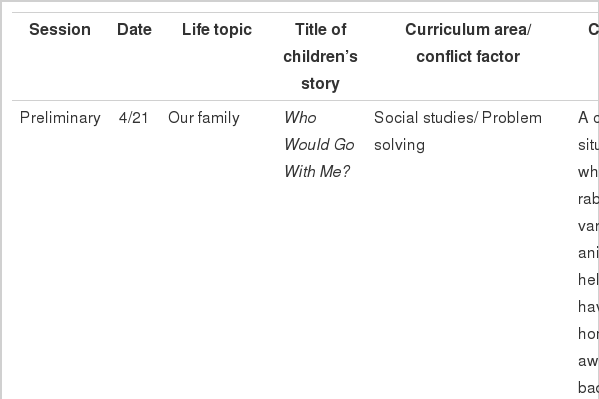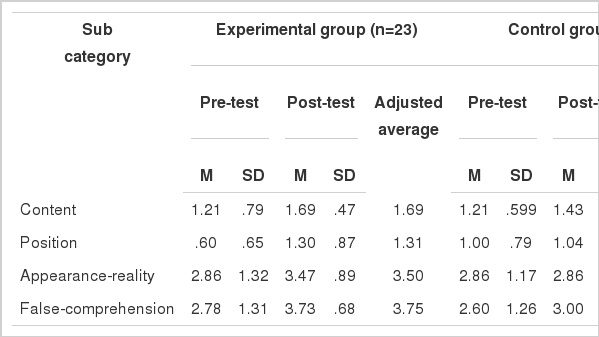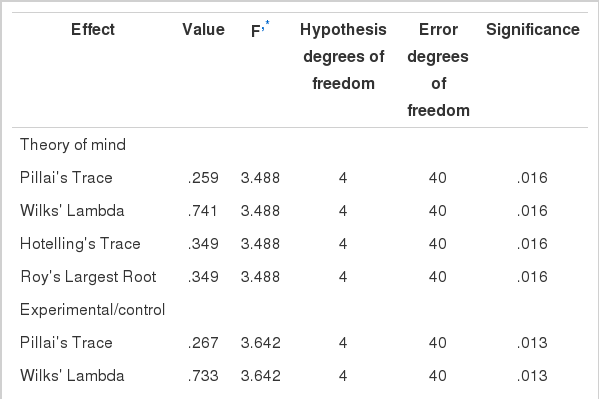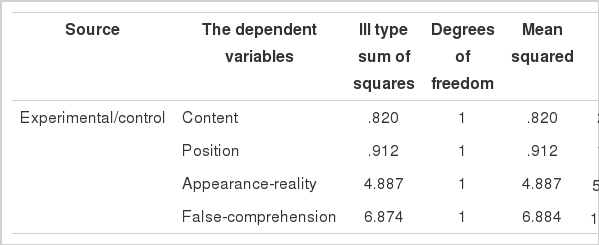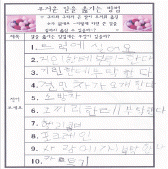동화를 활용한 갈등상황 이야기나누기 활동이 유아의 마음이론과 또래유능성에 미치는 영향
Effects of the Story Sharing Activity on Conflicting Situations by Using Children's Story on the Theory of Mind and Peer Competence of Preschoolers
Article information
Trans Abstract
The aim of this study is to examine the effects of the story sharing activity on-conflicting situations by the use of children’s story on the theory of mind and peer competences of preschoolers so that appropriate teaching materials can be allocated for the actual preschool education site. The subjects of this study were 46 preschoolers under the age 4 at the attached kindergarten of P University in Pohang City, Gyeongbuk and in which 23 children among them were assigned to a test group and the other 23 to a control group. The collected data was analyzed by SPSS ver. 15.0 program and Cronbach's α coefficient was yielded to verify the reliability for each scale. The multivariate analysis of covariance (MANCOVA) was conducted. The analysis results are as follows. First, the story sharing activity on conflict situations by using children’s story had a significant effect on the preschoolers’ general appearance and actual task as sub-factors of the theory of mind, whereas no significant effects were found regarding the content change task and position change task. Second, the story sharing activity on conflict situations by using children’s story had significant effect on the preschoolers’ overall sensitivity, insecurity and pro-sociability as sub-factors of the peer competences, whereas no significant effects were found regarding the aggression, exclusivity and anti-sociability.
서 론
1. 연구의 필요성 및 목적
여러 학자들은 사회적 능력발달에 있어 초기 또래경험의 중요성을 강조하고 있다. 비슷한 또래로 형성된 유아교육기관에서 유아들이 속하게 되는 집단은 매우 다양하고 역동적이며, 유아들은 집단 속으로 새로운 친구를 만났을 때 서로에게 관심을 갖고 함께 시간을 공유하게 된다. 수준 높은 또래관계를 유지하기 위해서는 놀이감을 나누고, 갈등을 해결하기 위해 감정을 조절해야 한다. 즉, 또래 간에 이루어지는 긍정적인 상호작용은 유아 개인에게 자부심과 만족감을 갖게 하고 사회인지 발달을 촉진함으로써 사회적 능력 발달의 기초가 된다[37]. 이러한 기초가 형성되면 유아는 스스로 또래관계의 중요성을 느끼고 자신이 속한 집단에 소속감을 느끼게 된다[34]. 최근 집단 내의 따돌림, 왕따라고 불리는 현상으로 인해 실제로 많은 아동들이 또래관계의 문제로 어려움을 경험하는 것으로 알려지면서[33], 유아기의 또래관계 형성은 더욱 중요한 의미를 지니게 되었다. Birch와 Ladd[4]는 또래관계가 원만한 유아들이 심리적으로 건강하고 적응을 잘하지만, 또래로부터 거부당하는 유아는 현재와 이후에 사회적 부적응을 나타낼 위험이 높다고 보고되었다. Lee [25]는 유아기의 바람직하지 못한 상호작용은 대인관계의 결함과 또래에게 수용이 되지 못하는 갈등상황의 부적응 행동이 나타나게 되며 성인기까지 영향을 줄 수 있다고 주장했다.
유아기에 또래와 효과적으로 관계를 형성하고 유지하는 기능으로 정의되는 또래유능성은 이후의 사회, 정서적 적응을 예측하는 중요한 요인이 된다[1, 12]. Chung [8]은 또래유능성을 유아가 또래와의 관계를 맺고 유지하는데 필요한 사회적 기술 뿐 아니라 인지적, 정서적 영역을 포함하는 포괄적인 능력으로 또래와의 관계에서 자신의 정서와 행동을 조절하고 또래와 원만한 관계를 유지하는 능력이라고 하였다. 또래유능성은 유아가 친구를 사귀고, 또래와 놀이를 하고, 의사소통과 갈등을 해결하는 다양한 상황에서 성공적으로 상호작용하는 사회적 기술을 나타내므로 이러한 사회적 기술이 발달한 유아들은 또래유능성이 높다고 할 수 있는 것이다[13, 2].
유아가 가족이라는 울타리를 벗어나 사회생활을 경험하게 되면서, 타인의 마음을 전혀 이해하지 못하는 ‘관계맺음’이 형성되면 또래집단에서 갈등상황을 겪게 된다. 현대사회에서 형제들끼리의 ‘관계 주고받음’이 익숙하지 못한 외동자녀들은 또래관계 형성에 대한 어려움을 더욱 크게 겪을 것으로 예측된다. 따라서 유아기에 다양한 갈등상황을 겪고 문제를 해결하는 경험은 반드시 필요하다. 이러한 갈등상황에 따른 문제들을 간접적으로 경험할 수 있는 가장 쉬운 매개체로 동화를 들 수 있다[28]. 유아는 동화 속 주인공을 통해 여러 가지 문제 상황을 경험하게 되고, 다양한 해결책을 상상해봄으로써 긍정적인 방법으로 갈등상황을 해결해나가는 태도를 배운다. 또한 문제에 대한 의문과 현실을 극복할 수 있는 해결능력을 기르게 된다. 2007 개정 유치원 교육과정에서도 이야기 나누기와 관련된 언어영역에서 말하기는 유아가 일상생활 속에서 접하는 다양한 사물과 사건에 대해 자신의 생각이나 느낌을 정확하게 말할 수 있도록 기회를 제공해야 한다고 제시하고 있다[30].
유아는 동화를 활용한 갈등상황 이야기나누기를 통해 다양한 갈등상황에 따른 긍정적인 해결책을 나름의 방법으로 해석해 봄으로써 타인조절과 자기조절을 학습하고, 대처하는 능력을 기르게 된다. 그러나 동화의 내용을 간접 경험을 하고 효과적인 또래관계 기술을 습득하게 되더라도 왜 그런 행동을 해야 하는지 깨닫지 못한다면 성숙한 사회적 관계를 형성하기는 쉽지 않을 것이다. 즉 성숙한 또래관계를 위해서는 타인의 마음을 이해하는 것이 필요하다고 볼 수 있다. 나의 마음을 이해하고 타인의 마음을 이해하는 능력, 즉 마음이론(theory of mind)은 사회적 관계 속에서 자신과 다른 사람의 생각이나 마음을 이해하고 다른 사람의 행동과 정서적 반응을 예측하는 심리활동이다[40].
여러 학자들은 동화를 통한 활동이 마음이론 발달을 촉진시킨다고 보고하고 있다[6, 36, 40]. Choi [6]의 연구는 친사회적 행동에 관한 그림책을 읽고 토의하기가 마음이론에 도움을 주고 있음을 제시하였고, Park [36]의 연구는 동화책을 통한 가장놀이 활동이 유아의 언어능력과 마음이론을 통해 발달이 이루어질 수 있다고 주장하였다. Rim [40]의 연구는 그림책을 활용한 이야기나누기가 유아의 마음이론 발달에 효과가 있음을 제시하고 있다.
연구들에서 제시하는 것은 마음이론이 사람들이 밖으로 표현하는 행동이나 감정과 내면으로 느끼는 바가 다를 수도 있음을 알고, 인간이 성공적인 사회적 상호작용을 하기 위해서는 반드시 필요한 능력이라는 점을 강조한다. 이러한 마음이론은 유아가 타인의 마음을 이해하고 반영하여 갈등상황에서 긍정적인 방법으로 문제 상황을 해결하는 것으로 유아기에 길러져야할 발달과업이라고 볼 수 있다. 이러한 측면에서 유아의 마음이론과 또래유능성에 대한 연구는 흥미로운 주제이며, 유아의 심리적인 능력과 사회적 능력의 발달적 연계를 밝히는 자료로서 의미 있는 연구라고 할 수 있다.
동화를 활용한 갈등상황 이야기나누기와 또래유능성과의 관계에 대한 연구를 살펴보았으나, 직접적인 관계 연구를 다룬 논문은 거의 없는 관계로 보다 넓은 영역에서 선행연구를 고찰해 보았다. 또래유능성 중의 하위요인[42]을 살펴보면 배척성, 비사교성, 친사회성, 불안정성, 과민성, 공격성 등이 있는데, 이 중에서 친사회성 요인과 동화를 활용한 갈등상황 이야기와의 관계 연구[20, 41, 35, 24, 25]들이 다수 나타나고 있다. 관련 연구 중에서 Kim[20]의 연구에서는 동화의 갈등상황에 대한 토의가 유아의 친사회적 행동에 도움이 된다고 제시하였고, Ryu [41]의 연구에서는 친사회적 추론 능력에, Park [35]과 Lee [24]의 연구에서는 친사회적 행동수준을 발달시킨다고 주장하였다. 이와 더불어 만 5세를 대상으로 한 Lee [25]의 연구에서는 갈등상황이 포함된 그림 동화책을 통한 역할놀이가 또래 간 유능성을 향상시킨다는 결과를 제시하고 있다. 이러한 연구들은 또래유능성의 하위요인 중 특정 일부분의 요인만 살펴보는 연구들로 이루어졌으며, 제시된 연구들의 대부분 연구들은 만 5세를 대상으로 이루어졌다. 그러나 만 4세 대상으로 한 연구는 거의 없는 실정이다. 만 4세는 또래관계의 빈도와 복잡성이 증가하고 또래로부터 인정과 수용을 받기 위해 다양한 시도를 하는 시기[34]인데도 불구하고 동화를 활용한 이야기나누기 활동이 또래유능성에 미치는 영향과 관련된 논문들이 부족한 실정인 관계로, 이에 연구의 필요성이 제기된다.
이에 본 연구에서는 만 4세의 유아에게 갈등상황이 내포된 동화를 들려주고 난 후 이야기나누기 활동이 유아의 마음이론과 또래유능성에 어떠한 영향을 미치는지 알아봄으로써 유아교육 현장에서 학습활동 자료로 활용할 수 있는 기초적인 정보를 제공하고자 하였다. 본 연구의 구체적인 연구문제는 다음과 같다.
1. 동화를 활용한 갈등상황 이야기나누기 활동이 유아의 마음이론에 영향을 미치는가?
2. 동화를 활용한 갈등상황 이야기나누기 활동이 유아의 또래유능성에 영향을 미치는가?
연구 방법
1. 연구 대상
본 연구의 대상은 경북 포항시에 소재하고 있는 P대학 부설 유치원에 재원하고 있는 만 4세 유아 2개 학급으로 총 46명의 실험집단(23명)과 통제집단(23명)으로 구성하였다. 연구대상의 선정은 경북 포항시에 위치한 유아교육기관 중에서 부모 및 교사의 인구통계학적 배경이 비교적 비슷한 P대학 부설 유치원의 만 4세 두 학급을 선정하였다. 실험집단과 통제집단을 24명씩 선정하였으나 이사로 인하여 중도 탈락한 2명을 제외한 각각 23명씩을 최종 선정하였다. 본 연구의 대상을 만 4세 유아로 선정한 이유는 만 4세는 사회인지발달과 함께 어떠한 반응에 대한 의도와 행동을 파악할 수 있는 능력까지 발달하며[9, 34], 유아가 만 3-4세가 되면 타인의 생각과 정서에 공감하고 감정 이입을 할 수 있게 되며 또래관계 형성에 큰 역할을 하게 되므로 본 연구대상으로 선정하였다.
연구대상의 연령과 성별, 평균 연령 및 연령범위는 Table 1과 같다. 연구대상 두 집단의 연령을 보면 실험집단(남9, 여14)의 평균 연령은 만 4세 1개월이고 통제집단(남8, 여15)의 평균 연령은 만 4세 3개월이며 두 집단 간의 평균연령은 만 4세 2개월이었다. 실험집단과 통제집단의 교사는 3년제 전문대학 유아교육과를 졸업한 교사로서 유치원 2급 정교사 자격증을 소지하였으며 유치원 경력은 2년 10개월과 1년 10개월이었다.
2. 연구 도구
1) 동화책 선정
본 연구에서 사용되는 동화책은 갈등상황이 내포된 동화로 선정하였으며 예비검사용 1권, 실험처치용 24권의 총 25권으로 동화책 선정방법은 다음과 같다.
첫째, 동화책의 선정기준은 Lee 등[26]의 『 유아에게 적절한 그림책』추천도서와 Park [32]의 동화선정기준을 참조하여 선정하였다. 문학적 장점이 있는 책, 발달적 수준에 적합한 책, 유아들이 일상생활에서 접할 수 있는 문제 상황과 사건의 전개, 절정, 결말이 있는 내용, 갈등상황이 분명하게 드러나서 유아들이 토의의 논점을 충분히 이해할 수 있는 것으로 하였다.
둘째, 선정된 동화책은 Lee 등[22]의 『통합적 접근을 위한 Caldecott Medal 수상 도서 연구』에 제시된 동화 중에서 ‘도덕적 갈등상황’이나 ‘문제 상황’이 내포되어 있는 동화로 문제해결, 의사소통, 반 편견의 갈등요인이 포함되어 있는 동화내용을 선별하였다. 본 연구자와 유아교육 전공 교수 1명, 20년 이상 경력의 석사학위 소지자 병설유치원교사 1명 및 16년의 교육경력을 가진 유치원 원감 1명 등 총 4명의 검토를 거쳐 예비연구 1권과 본 연구 24권 총 25권을 최종 선정하였다.
2) 동화책을 활용한 이야기나누기
동화책을 활용한 이야기나누기 활동은 Lee 등[23]과 Park [31]이 제시한 교육방법을 Kim [19]의 토의교수 전략을 참고로 연구한 Park [32]의 선행연구를 본 연구자가 재구성하였다.
실험집단에 적용된 동화책을 활용한 이야기나누기 활동 프로그램 구성 체계는 Tyler의 교육과정 구성 체계에 기초하여 목적, 목표, 내용, 교수-학습 과정, 평가로 나누어 살펴보았다[44, 45]. 본 연구의 실험집단의 동화를 활용한 이야기나누기 절차는 Table 2와 같다.
마음이론은 잘못된 신념 이해 과제와 외양-실제 구분 과제의 총점을 의미한다.
(1) 잘못된 신념 이해 과제
유아의 마음이론 이해 수준을 파악하기 위해 전형적인 틀린-믿음 과제를 사용하였다. 잘못된 신념 이해 과제는 Smarties과제(내용교체과제) [38]와 Maxi과제(위치이동과제) [46]를 Bae와 Choi [3]의 연구에서 사용한 방법을 적용하였다. 유아가 얻을 수 있는 마음이론 검사의 총점은 위치이동 과제에서 얻을 수 있는 점수와 내용교체 과제에서 얻을 수 있는 점수를 합한 점수이며, 유아 1인당 마음과제 총점의 범위는 0-4점이 된다.
위치이동과제는 다른 사람이 틀린 믿음을 가질 수 있다는 것을 이해하고, 다른 사람이 가지고 있는 틀린 믿음에 따라 행동할 것을 유아가 예측하는지를 측정하는 것이다[5]. Maxi과제는 남녀 인형을 사용하여 내용물(딸기)을 제시하고 다른 곳으로 옮기며 유아가 내용물(딸기)이 어디에 있다고 생각하느냐와 왜 그렇게 생각하는지를 질문하여 유아가 마음의 표상적 특성을 이해하는지를 판단하는 과제이다(Figure 1). 정답이면 1점, 오답이면 0점으로 처리하였다.

(A) Theory of mind smarties subject (replace the contents of a challenge). (B) Theory of mind maxi subject (position challenges). (C) Theory of mind (lookphysical separation challenges).
Smarties과제는 자신이 실제와는 다른 표상을 하여 틀린 믿음을 가지는 것처럼 다른 사람도 실제와 다르게 틀린 믿음을 가질 수 있다는 것을 유아가 이해하고 있는지를 측정하는 것이다[5]. 유아에게 껌 그림이 그려진 상자에 껌 대신 색연필이 들어있는 것(Figure 1)을 보여 준 후, 이 상자를 다른 사람에게 보여주면 상자 안에 무엇이 들어 있을 것이라 생각하는지, 왜 그렇게 생각하는지를 질문하여 유아의 틀린-믿음을 판단한다. 유아에게 처음 상자를 봤을 때의 답과 상자를 열어 보지 않은 친구들의 반응을 질문한 후 정답이면 1점, 오답이면 0점으로 처리하였다. 점수가 높을수록 마음이론이 잘 발달되었다고 판단된다.
(2) 외양-실제 구분 과제
외양-실제 구분 과제는 선행연구[10, 29]를 바탕으로 본 연구자가 수정·보완한 척도를 사용하였다. 유아에게 사물의 외양과 그 사물의 실제를 나타내지 않는 두 사물을 보여 준다. 책처럼 보이는 상자와 치약처럼 보이는 볼펜을 보여준다(Figure 3). 각 사물을 만져볼 잠깐 동안의 시간을 준 후 연구자가 유아에게 두 가지 질문을 하였다.
첫 번째 질문은 외관실제구분능력이며, 사물의 외양을 묻는 것(외관과 실제 사이를 구별하는 능력)으로서 ‘네가 지금 그것을 보았을 때, 그것은 상자(볼펜)처럼 보이니, 책(치약)처럼 보이니?’이다. 만약 유아가 보이는 사물을 정확하게 답한다면 즉, 책(치약)이라고 대답한다면 2점을 주어 최대 4점이 된다.
두 번째 질문은 허위이해능력이며, 그 사물의 실제를 묻는 것(똑같은 사물 또는 상황에 대해 다른 표상을 조절하는 능력)으로서 ‘이것은 진짜 무엇이니?’이것은 책(치약)이니, 상자(볼펜)이니? 이다. 이 질문에 대해 유아가 그 사물의 실제를 정확하게 답한다면 2점을 주어 최대 4점이 된다. 따라서 외양-실제 구분 과제의 점수범위는 0-8점이며, 점수가 높을수록 마음이론이 잘 발달되었다고 판단된다.
3) 또래유능성
유아의 또래유능성을 측정하기 위해 Ladd 등[21]이 제작한 교사용 유아행동 척도(child behavior scale, CBS)를 Song [42]이 번역한 도구를 사용하였다. CBS는 총 6개의 하위 영역으로 구성된 35문항의 질문지로서 공격성, 비사교성, 배척성, 불안정성, 과민성요인은 점수가 높을수록 또래유능성이 낮은 것으로, 친사회성은 점수가 높을수록 또래유능성이 높은 것으로 해석하였다. 유아의 또래유능성 검사의 신뢰도를 검증하기 위하여 Crobach’s a를 산출하였다. 유아의 또래유능성 전체 신뢰도 계수는 .891이며, 각 하위 요인별 문항 번호와 내적 일치성 신뢰도는 공격성 하위요인은 .864, 친사회성 하위요인은 .861, 비사교성 하위요인은 .685, 배척성 하위요인은 .821, 불안정성 하위요인은 .923, 과민성 하위요인은 .835 등이다.
3. 연구 절차
본 연구의 전체 과정의 구체적 내용은 Table 3과 같다.
1) 본 연구
(1) 사전검사
마음이론 검사는 유아 1명당 검사 시간이 4-5분이 소요되었으며, 하루일과 중 자유선택활동 시간을 활용하여 본 연구자가 일대일 개별검사로 실시하였다. 검사 장소는 P시에 위치한 P유치원의 별도의 공간(도서관)에서 이루어졌으며 정확도를 높이기 위해 녹음 전사하였으며 연구자와 보조 연구자는 유아가 대답한 답을 검사지에 기록하였다.
(2) 실험처치
① 실험집단
실험집단의 유아들은 자유선택활동 시간에 동화를 듣고 이야기나누기를 한 후 이에 관련된 사후 활동을 실시하였고 프로그램에 따라 대집단과 소집단, 개별 활동으로 나누어 전개되었다. 본 연구에서 실시된 실험처치 과정으로 갈등상황의 동화는 Table 4에 제시되어 있으며, 연구가 진행되는 과정에서 실험집단의 일일 교육계획안의 예는 Table 5에 제시되어 있다.
② 통제집단
본 연구의 통제집단 유아들은 실험집단과 동일한 환경인 별도의 공간(도서관)에서 이루어졌으며 본 연구자가 동화를 들려준 후 P유치원의 교육과정에 따라 자유 선택 활동을 하였다. 통제집단 유아들은 동화와 관련된 갈등상황이야기나누기 활동 프로그램은 실시하지 않았다.
(3) 사후검사
24회의 실험처치가 끝난 후 2009년 7월 21일부터 2009년 7월 23일까지 3일 동안 본 연구자와 연구보조자 1명이 실험집단과 통제집단 유아를 대상으로 실시하였다. 채점은 본 연구자와 보조연구자 1명이 마음이론 과제 점수기록표에 기록된 유아들의 반응 점수표를 관찰하여 기록하였으며 채점자간 신뢰도는 실제요인 Cronbach's α =.977, 위치요인 Cronbach's α =1.00, 외양요인 Cronbach's α =1.00, 내용요인 Cronbach's α =1.00으로 나타났다. 또래유능성 검사는 2009년 7월 20일 2차 안내문과 질문지를 배부하였고 교사가 따로 작성하여 2009년 7월 23일에 회수하였다.
4. 자료 분석
연구문제에 대한 분석을 위해 수집된 자료는 SPSS ver. 15.0(SPSS Inc., Chicago, IL, USA)을 이용하여 자료를 분석하였다. 자료 분석으로는 첫째, 측정도구의 신뢰도를 알아보기 위해 Cronbach's α 계수를 산출하였다. 둘째, 마음이론과 또래유능성의 사전 점수를 공변인으로 하고 실험집단과 통제집단을 독립변인으로 마음이론과 또래유능성의 사후 점수를 종속변인으로 하여 다변인 공변량 분석(MANCOVA)을 실시하였고 .05수준에서 통계적으로 유의성을 검증하였다.
연구결과
1. 동화를 활용한 갈등상황 이야기나누기 활동이 유아의 마음이론에 영향을 미치는가?
동화를 활용한 갈등상황 이야기나누기 활동이 유아의 마음이론에 영향을 미치는지를 검증하기 위해 분석한 결과는 다음과 같다.
실험집단과 통제집단 간 마음이론의 하위 요인별 사전·사후 검사의 평균, 표준편차 및 조정된 평균을 나타내었다(Table 6).
동화를 활용한 갈등상황 이야기나누기 활동의 실시여부(실험집단, 통제집단)를 독립변인으로, 마음이론의 사전검사를 공변인으로 하고 마음이론의 사후점수를 종속변인으로 하여 공변량 분석을 실시한 결과를 나타내었다(Table 7).
동화를 활용한 갈등상황 이야기나누기 활동이 유아의 마음이론에 미치는 영향에 관한 MANCOVA분석 결과, 마음이론의 사전검사의 공변인 효과(Wilks’ Lambda, F=3.488, p<.05)가 통계적으로 유의한 것으로 나타났으며 동화를 활용한 갈등상황 이야기나누기 활동이 주효과 또한 공변인 효과(F=3.642 p<.05)값을 포함한 모든 다변인 변량분석치가 유의한 것으로 나타났다. 통계적으로 유의한 것으로 나타난 동화를 활용한 갈등상황 이야기나누기 활동이 유아의 마음이론에 미치는 영향의 구체적인 차이를 알아보기 위해 단변인 변량분석을 실시하였다(Table 8).
동화를 활용한 갈등상황 이야기나누기 활동이 유아의 마음이론에 미치는 주효과를 검증한 결과, 내용교체과제, 위치이동과제의 하위 요인에서는 실험집단 유아의 평균이 각각 1.69, 1.31을 나타내었으며 통제집단의 경우는 각각 1.42, 1.03을 나타냄으로써 실험집단과 통제집단 간에 유의한 차이가 없는 것으로 나타났다. 또한 외관실제구분능력, 허위이해능력의 하위 요인에서는 통계적으로 유의한 차이가 있는 것으로 나타났다. 즉 외관실제구분능력의 경우, 실험집단(평균=3.50)의 유아가 통제집단(평균=2.84)의 유아에 비해 유의하게 높은 점수를 얻은 것으로 나타났다. 허위이해능력의 요인에서도 실험집단(평균=3.75)의 유아가 통제집단(평균=2.98)의 유아에 비해 유의하게 높은 점수를 얻음으로써 동화를 활용한 갈등상황 이야기나누기 활동이 유아의 마음이론에 비교적 영향을 미치는 것으로 나타났다.
2. 동화를 활용한 갈등상황 이야기나누기 활동이 유아의 또래유능성에 영향을 미치는가?
동화를 활용한 갈등상황 이야기나누기 활동이 유아의 또래유능성에 미치는 영향을 검증하기 위해 분석한 결과는 다음과 같다.
실험집단과 통제집단 간 또래유능성의 하위 요인별 사전·사후검사의 평균, 표준편차 및 조정된 평균을 나타내었다(Table 9).
갈등상황 이야기나누기 활동의 실시여부(실험집단, 통제집단)를 독립변인으로, 유아의 또래유능성의 사전검사를 공변인으로 하고 유아의 또래유능성의 사후점수를 종속변인으로 하여 공변량 분석을 실시하였다(Table 10).
동화를 활용한 갈등상황 이야기나누기 활동이 유아의 또래유능성에 미치는 영향에 관한 MANCOVA분석 결과, 유아의 또래유능성 사전검사의 공변인 효과(F=7.194, p<.001)가 통계적으로 유의한 것으로 나타났으며 동화를 활용한 갈등상황 이야기나누기의 주효과도 공변인 효과(F=4.763, p<.01)값을 포함한 모든 다변인 변량분석치가 유의한 것으로 나타났다. 이와 같은 결과는 유아의 또래유능성을 향상시키는데 동화를 활용한 갈등상황 이야기나누기 활동이 효과가 있음을 의미한다.
동화를 활용한 갈등상황 이야기나누기 활동이 유아의 또래유능성에 미치는 주 효과를 검증한 배척성, 비사교성, 공격성의 하위 요인에서는 실험집단 유아의 평균이 각각 8.13, 6.21, 5.52를 나타내었으며 통제집단의 경우는 각각 8.47, 6.87, 6.86을 나타냄으로써 실험집단과 통제집단 간에 유의한 차이가 없는 것으로 나타났다. 그러나 친사회성, 불안정성, 과민성의 하위 요인에서는 통계적으로 유의한 차이가 있는 것으로 나타났다. 즉 친사회성의 요인에서 실험집단(평균=30.23)의 유아가 통제집단(평균=25.93) 의 유아에 비해 유의하게 높은 점수를 얻은 것으로 나타났다. 또한 불안정성의 요인에서도 실험집단(평균=4.87)의 유아가 통제집단(평균=6.55)의 유아에 비해 유의하게 낮은 점수를 얻은 것으로 나타났으며, 과민성의 요인에서도 실험집단(평균=5.52)의 유아가 통제집단(평균=6.86)의 유아에 비해 유의하게 낮은 점수를 얻음으로써 동화를 활용한 갈등상황 이야기나누기가 유아의 또래유능성에 비교적 영향을 미치는 것으로 나타났다(Table 11).
논의 및 결론
본 연구는 동화를 활용한 갈등상황 이야기나누기 활동이 유아의 마음이론과 또래유능성에 미치는 영향을 알아보기 위한 목적을 지녔다. 연구문제를 중심으로 논의를 하면 다음과 같다.
1. 동화를 활용한 갈등상황 이야기나누기 활동이 유아의 마음이론 에 미치는 영향
동화를 활용한 갈등상황 이야기나누기 활동이 유아의 마음이론에 미치는 영향을 분석한 결과, 마음이론 2가지 척도인 잘못된 신념 이해와 외양-실제 구분과제 중 잘못된 신념 이해의 하위요인인 내용교체 과제와 위치이동 과제는 유의미한 차이가 없는 것으로 나타났다. 외양-실제구분과제의 하위요인인 외관실제구분능력과 허위이해능력에서 유의한 차이가 있는 것으로 나타났다.
마음이론 하위요인인 외관실제구분능력과 허위이해능력에서 유의한 차이가 나타난 본 연구결과는 혼합연령을 대상으로 한 Choi [6]의 연구, 5세를 대상으로 한 Park [36]의 연구, 4세를 대상으로 한 Rim [39]의 연구 결과들과 맥락을 같이 하고 있다[6, 36, 39]. Choi [6]는 친사회적 행동에 관한 그림책을 읽고 토의하기가 마음이론에 긍정적인 영향을 미쳤다고 보고하였다. Park [36]의 연구에서는 동화책을 통한 가장놀이 활동이 유아의 언어 능력과 마음이론에 유의미한 영향을 미쳤다는 결과가 나타났고, Rim [39]의 연구에서도 정서지능 요소와 마음이론 요소가 포함된 그림책을 활용한 주제 환상극 놀이 연구에서 긍정적인 영향을 미쳤다고 보고하였다. 이러한 결과는 유아가 동화를 듣는 것만으로 끝나는 것이 아니라 실제로 이야기나누기 활동을 통해 타인의 역할을 간접 경험하는 것이 타인에 대한 마음현상 이해를 증진 시키는데 효과적임을 의미한다.
반면, 내용교체 과제와 위치이동 과제에서는 실험집단의 유아들과 통제집단 유아들 간 점수는 유의미한 차이가 나타나지 않았다. 만 4세 유아를 대상으로 마음이론 요소가 포함된 그림책을 활용한 집단게임 활동이 유아의 마음이론과 사회적 행동에 미치는 효과와 마음이론과 사회적 행동 간 상관관계에 대해 연구한 Kang [18]은 위치이동 과제에서 통계적으로 유의미한 차이가 나타나지 않았다고 보고한 연구 결과와 맥을 함께 하고 있다. Kang의 연구에서는 사전검사 중 유아들이 내용교체 과제를 이해하지 못하고 오답을 말한 경우가 많았고, 위치이동 과제 경우에는 사전검사에서 과제에 대한 이해도가 높았기 때문에 사후검사에서 집단 간 유의미한 차이가 나타나지 않았다고 해석하고 있다.
이는 마음이론의 과제를 약간 변형하거나 학습을 시켜서 연구에 적용할 때 4세 미만의 아동은 일관되게 이 과제를 해결하지 못한다는 연구결과[11]를 고려해 본다면 본 연구에서의 실험이 3-4월 학기 초에 실시하였기 때문에 발달과제를 충분히 수행하지 못한 발달단계를 적용하였기 때문이라고 유추하여 후속연구에서는 평균적인 만 4세 유아를 대상으로 연구를 적용할 필요성이 보인다. 또한 잘못된 신념 이해 영역의 마음이론에서 만 4세 유아가 다른 사람의 틀린 믿음뿐만 아니라 행동까지 예측해야 하기 때문에 다른 하위 요인에 비하여 좀 더 어려운 과제이기 때문에 영향을 미치지 않은 것으로 여겨진다[16].
2. 동화를 활용한 갈등상황 이야기나누기 활동이 유아의 또래유능성에 미치는 영향
동화를 활용한 갈등상황 이야기나누기 활동이 유아의 또래유능성에 미치는 영향을 알아본 결과, 친사회성, 과민성, 불안정성 하위요인이 통계적으로 유의미한 영향을 미치고 있는 것으로 나타났으며, 공격성, 배척성, 비사교성은 유의미한 차이가 없는 것으로 나타났다.
본 연구에서 실시한 또래유능성에 대한 동화를 활용한 갈등상황 이야기나누기의 영향력을 보고한 연구들은 많지 않은 관계로 또래유능성의 하위요인의 선행연구들을 살펴본 결과 하위 요인들 중의 하나인 ‘친사회성’요인과의 관계를 살펴본 연구[20, 35, 7, 14, 43]결과들과 일부 맥락을 같이 하고 있다. Kim [20]의 연구에서는 동화의 갈등상황에 대한 토의가 유아의 친사회적 행동을 증진시켰다는 결과가 나왔으며. Park [35]의 연구에서는 만 4, 5세 유아를 대상으로 갈등상황에 대한 동화를 들려주고 토의활동을 한 결과 유아들이 친사회적 행동수준이 향상되었음을 보고하였다. Choi [7]의 연구에서는 만 5세 유아를 대상으로 생활동화를 활용한 갈등상황 토의가 친사회적 행동에 미치는 것으로 보고하였다. 또한 Hwang [14]의 연구에서도 도덕적 갈등상황에 관한 토의활동이 유아의 친사회적 행동에 토의 활동을 경험하지 않은 비교집단 보다 유의하게 높은 것으로 나타났다. Trepanier 등[43]은 5세와 7세의 유아에게 갈등상황이 포함된 그림이야기를 들려주고 친사회적 행동발달에 긍정적 영향을 미치는지에 대한 연구를 한 결과 두 개의 갈등상황 그림에 반응한 것을 측정한 연구결과에서는 유의한 효과는 없었으나, 실험집단이 대인갈등을 해결하는 방법으로 말하고 다른 사람의 감정을 이용하는 능력이 향상되었음을 보고하였다. 이러한 결과는 만 4세의 유아가 갈등상황의 문제점을 이해하고 이야기나누기 과정을 통해 다른 사람과 자신의 입장을 이해할 수 있으며, 타인을 존중하는 마음과 감정 조절을 키움으로써 친사회적 요인에 영향을 미친 것으로 보인다.
다음으로 동화를 활용한 갈등상황 이야기나누기 활동이 유아의 또래유능성 중 과민성 요인과 불안정성 요인에 영향을 미친 것으로 나타났다. 이는 또래유능성 중 친사회성 하위변인과의 관련성 연구들이 대부분 없는 것과 마찬가지로 과민성, 불안정성 하위요인과의 영향을 다룬 연구는 거의 없는 실정이다. 다만 동화를 활용한 인성교육프로그램의 효과를 다룬 Jung [17]의 연구와 넓은 의미에서 맥을 함께 하고 있다. 제시한 연구에서는 4-5세를 대상으로 인성교육프로그램을 적용한 동화를 활용하여 유아의 자기조절능력과 또래유능성에 영향을 미친다고 제시하였다. 과민성의 요인은 감정적으로 지나치게 예민하고 침착하지 못한 행동 특성을 나타내는 것이다[42]. 과민성이 높은 아동은 주변 환경이나 또래, 교사와의 관계에 따라 영향을 많이 받는다. 즉 교사의 행동과 언어에 예민하게 반응하는 유아는 자기조절력에 영향을 받기 때문에 동화를 활용한 갈등상황 이야기나누기 활동이 유아의 또래유능성 중 과민성 요인에 영향을 미친 것으로 여겨진다. 또한 불안정성 요인은 공연한 근심과 걱정이 많고, 쉽고 잘 울며 낯선 상황에 가면 불안해하는 등의 행동 특성이다[42]. 동화를 활용한 갈등상황 이야기나누기 활동을 함으로써 교사와 유아, 또래와 유아들 간의 성공적인 상호작용을 함으로써 긍정적인 사회적 기술을 익힘으로 유아의 불안정성 요인이 낮아지는 것으로 여겨진다. 이러한 결과는 유아가 갈등상황에 따른 문제를 해결해 나가는 과정에서 또래에 대해 서로의 이야기를 경청하고 다른 감정과 입장을 수용·이해함으로써 또래와의 긍정적 관계형성 향상에 효과적임을 의미한다.
반면, 또래유능성의 하위요인인 공격성. 배척성, 비사교성에서는 동화를 활용한 갈등상황 이야기나누기 활동을 경험한 실험집단의 유아들과 통제집단 유아들 간 점수는 유의미한 차이가 나타나지 않았다. 앞에서 제시하였듯이 또래유능성에 대한 동화를 활용한 갈등상황 이야기나누기의 영향력을 보고한 연구들은 많지 않은 관계로 또래유능성의 하위요인의 선행연구들을 살펴본 결과 먼저 하위 요인들 중의 하나인 ‘공격성’요인과의 관계를 살펴본 Jeon [15]의 연구 결과와 일부 맥락을 같이 하고 있다. 이 연구에서는 그림책을 활용한 공감증진 독서치료 프로그램에서 공격성의 하위 요인 중 언어적 공격성 감소 효과가 나타나지 않았음을 보고하고 있다[15]. 또래유능성 하위 요인 중 공격성 요인은 또래들과 쉽게 잘 다투거나 친구들을 괴롭히고 신체적으로 폭력을 휘두르는 등의 행동을 나타내는 것이다. 또한, 배척성 요인은 또래들이 싫어하고, 놀이 친구로 선택하지 않으며, 친구들에게 무시당하는 등의 행동 특성을 나타내는 것이며, 비사교성은 또래 아이들과 놀기보다 혼자 노는 것을 좋아하고, 내성적이며, 친구들과 잘 어울리지 못하는 등의 특성이다[42]. 이러한 요인들의 결과들은 동화를 활용한 갈등상황 이야기나누기 활동 프로그램 내용 대부분이 또래에게 대화나 협동놀이, 도와주기와 같은 친사회적 행동을 많이 적용한 영향인 것으로 보이고, 또한 자기중심적 사고에서 벗어나지 못한 4세 유아들의 기질적인 영향과 이 유아들의 또래 집단에서의 부정적인 영향 즉, 공격성, 배척성, 비사교성 등의 효과적인 영향을 발휘하지 못한 것으로 유추된다.
위의 연구결과들을 종합해 보면 동화를 활용한 갈등상황 이야기나누기 활동은 유아들이 동화를 통해 자유롭게 상상하며 서로의 생각을 이야기하고 문제 해결책을 제시하는 등 결과적으로 타인의 마음을 이해하는 과정에서 부분적으로 또래관계가 향상됨을 알 수 있었다. 이는 동화를 통한 갈등상황 이야기나누기 프로그램이 유아의 마음이론과 또래유능성에 적절하고 의미 있는 교수자료로 활용될 수 있음을 말한다. 또한 동화책 속의 갈등상황에 따른 간접 경험을 할 수 있는 환경을 제공한다면 또래 관계가 긍정적 효과를 줄 수 있다는 점에서 이 논문의 의의를 찾을 수 있다.
끝으로 본 연구의 결론을 토대로 앞으로의 연구방향을 위하여 제언을 한다면, 본 연구에서는 동화를 선정 할 때 칼데콧 상 수상작을 사용하였다. 그러나 마음이론의 하위요인에 있어서 전래동화가 생활동화, 상상 동화에 비해 마음이론과 관련된 내용을 더 많이 포함하고 있다는 연구[27]결과가 제시된 것을 볼 때 유아들이 일상생활에서 경험한 실질적 내용이 있는 갈등상황을 중심으로 한 전래동화, 생활동화 및 다양한 종류의 동화를 활용한 갈등 상황에 대한 연구를 후속연구로 제안을 하고자 한다.
Notes
The authors declared that they had no conflicts of interest with respect to their authorship or the publication of this article.



